Four from the Greek Chorus
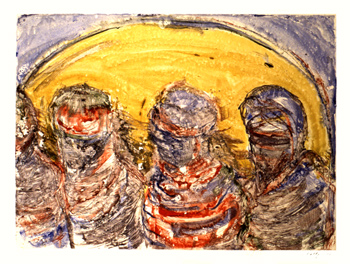
Veils Suite: Four from the Greek Chorus
monotype 45 x 60 cm.

Veils Suite: Four from the Greek Chorus
monotype 45 x 60 cm.
December 8, 2004 in Printworks, Veils Suite Comments Off on Four from the Greek Chorus

still image from untitled (left side/right side) © Elisa Rathje
I am proud to introduce my daughter Elisa, a 1998 graduate of the Emily Carr Institute (of Art, Design and Media) who works with computer-generated images and digital video. One of her video works is showing at The Western Front artist-run centre in an exhibition called:
Untitled (Conversation Loops)
Miguel da Conceicao, Jacob Gleeson, Donato Mancini, Elisa Rathje
Excerpts from the exhibition statement:
Untitled (Conversation Loops) features the work of four Vancouver-based artists working with tautologies, multiples and closed loops of language and dialogue in four very different works.
In her 2-channel video work left side/right side, Rathje continues her interest in mirrors, multiples, and the body in relation to the gaze. Using two Point-of-View shots, the video depicts an intimate moment of waking up next to a partner or lover. However, in Rathje’s work, both images are of the artist herself, creating a confusing twinning of the intimate other.
Please read the whole statement about the other artists’ work as well.
That’s at the The Western Front, 303 East 8th Avenue, Vancouver until December 18, 2004
Some of Elisa’s past projects include street banners for the cities of Vancouver and North Vancouver
December 7, 2004 in Art Exhibitions, Other artists 11 Comments »
Finland is celebrating its 87th Independence Day (Itsenäisyys Päivä) today, December 6th. Though I’m a proud Canadian, I’m also proud of my birth country.
Finland was part of the Swedish realm for some 600 years up to 1809 and then attached to the Russian empire for just over a century. The Grand Duchy of Finland, as part of the Russian Empire enjoyed extensive autonomy. Gradually Finnish nationalism grew and in 1906 “Finland acquires its own national parliament, elected by equal and universal suffrage, a development that makes Finnish women the first in the world to be granted full national political rights, that is to say suffrage and eligibility to stand for election to their national Parliament.” Shortly after the Bolshevik Revolution in Russia in 1917, Finland declared Independence.
If you’d like to learn more about Finland, Virtual Finland* is the excellent main portal with very good history pages. Wikipedia is good too.
Later: On a side note, this just came in on BBC: Finland is rated the best in education in math and reading. Canada is third.
* The Virtual Finland site no longer exists so link has been removed.
December 6, 2004 in Culture, Finland, Estonia & Finno-Ugric, History Comments Off on Finland’s Independence Day
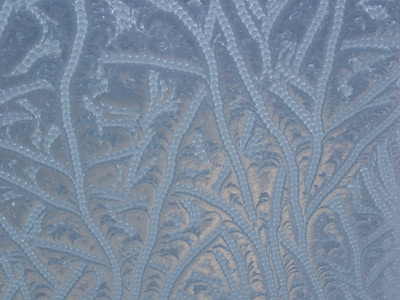
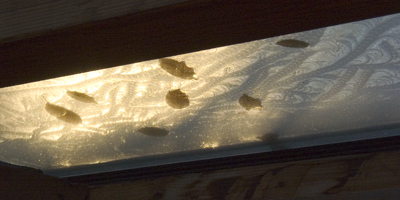
Sunday morning’s visual treat was to find our unheated solarium skylights covered over in the most beautiful and intricate frost patterns. I think this complexity is rare here on the west coast. It had been raining very heavily for several days, but cleared and became cold overnight. Notice some leaves trapped in the frost in the lower photos. The bottom photo (below) is taken of the roof glass on the outside, notice how thick the ice is. The sun’s rays quickly melted all away, a fleeting art installation.
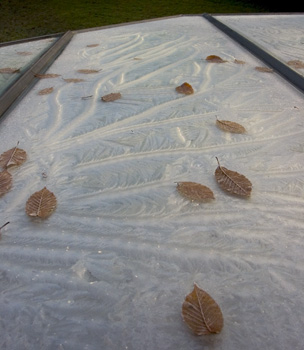
“Mathematicians explain that both ferns and frost are fractals — self-replicating patterns — which makes them no less mysterious.” from Frost Smitten
Dr. Universe explains why frost on a window looks like plant life (leaves, ferns and such).
With this display of Jack Frost’s art, the mountain tops white with snow and the forecast calling for more cold weather and possible flurries, I’m now feeling in the Christmas mood. Is it because the first half of my life was spent in places with real winters?
December 5, 2004 in Nature, Photoworks 6 Comments »
William Blake (1757-1827) “was an artisan in the truest sense: his craftsmanship played a role in every creative aspect of his poetic and prose works. William Blake thought, wrote, prepared, designed, engraved, and printed all pieces his name would grace.”
An impressive collection of 174 of William Blake’s artwork – drawings, watercolours, tempera, etchings and engravings for his famous bookmaking and illustrations can be viewed on Tate Online. These include interesting biographical, historical or technical notes. I’m particularly interested in his printmaking so I’ve selected a few highlights below. (Navigation is a bit slow to get directly to a particular image.)
Image 21-” He developed a technique for integrating both text and image onto a single etching plate for printing. This reflects the intimate relationship he saw between image and text, each being a comment upon the other.”
Image 22-” Blake’s invention of a method of printing in relief from etched plates, first used in 1788, gave him control over the style, production and publishing of his own books. By 1794 he had begun applying coloured pigments to his printing plates and then, as a further development, printing some of the designs in his books as separate coloured images.”

Newton – 1795/circa 1805 Colour print finished in ink and watercolour on paper – from Tate Online
Image 27 (above) – “The complexity and quality of the colour-printed areas of the rock, and the high degree of hand-finishing applied to Newton’s flesh and hair, show the great technical proficiency he had acquired through his colour-printing experiments from the mid 1790s.”
Images 74 to 107 – Blake “experiments with a new medium; he had never engraved on wood before. Even at the age of sixty-four he wanted to make further explorations in his art.”
Image 152 – “Blake produced about a hundred drawings and watercolours to illustrate the Divine Comedy, and had intended to make engravings of these designs. However, at the time of his death, in 1827, he had completed only seven engravings. These were published later by John Linnell… This is one of the seven engravings.”
More on Blake’s Life as man, artisan, writer, thinker, and on his method of etching & engraving.
Lots of links on Blake’s writing at Wood s Lot, Nov.28th, 2004 – thanks for the Blake at the Tate link!
December 4, 2004 in Other artists, Printmaking 2 Comments »
Mark your calendars. Master printmaker Taiga Chiba will discuss his experiences teaching printing techniques to Inuit artists in the Canadian North. A slide presentation will be followed by a guided tour of the exhibition Experimental Prints from Baker Lake.
This is at the Marion Scott Gallery, in its new location in Gastown at 308 Water Street, Vancouver, BC on Saturday, December 11th from 2:00 to 3:00 pm. Refreshments will be served.
Do look at the online gallery to see the delightful results of these Inuit artists’ experiments with new techniques. The exhibition is on until January 5, 2005.
December 2, 2004 in Art Exhibitions, Other artists, Printmaking 6 Comments »
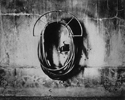
Steven Dixon: Mine Site No. 17
photogravure 58 x 70 cm
Master printer, teacher and friend Steven Dixon just let me know that some of his photogravure prints are on exhibition at Lando Gallery in Edmonton, Alberta until December 11th. If you are in the area, you must see them; if not, the gallery website gives us a good look.
Photogravure is an old technique that has had something of a revival, and Steven has mastered it superbly. If you are interested in learning more about photogravure Steven has two sites to recommend:
Kamakura Print Collection is a bit long but has good reproductions and good information.
Lothar Osterburg’s site is good, not quite as detailed but easy to understand.
You might recall Steven’s name because I’ve posted about some of his exhibitions this year as well as the “Traces” exhibition that Steven, Bonnie Jordan and I presented in Pohjanmaan Museum in Vaasa, Finland in 2002.
December 1, 2004 in Art Exhibitions, Other artists, Printmaking Comments Off on Steven Dixon
Pierre Berton died today at the age of 84. A well-known award-winning author of 50 books and a broadcaster, he was one of Canada’s best known and beloved figures. He wrote about his life in the Yukon and about Canada with love, becoming a Canadian icon himself. I feel as if I have lost an old friend.
I’m sure there will be a great deal written about him in the coming days, but for now, here is the announcement in CBC, and his life story on Wikipedia.
UPDATES: CBC and Canada.com
November 30, 2004 in Books, Culture Comments Off on Pierre Berton 1920-2004

The Studio Art printmaking department at Capilano College is holding their always popular Annual Print Sale, featuring intaglio, relief, silk screen and digital prints created by students and faculty members in the Studio Art program. Do come and support the students and get some original artworks for some lucky people on your Christmas list!
That’s on Tuesday, December 7th, 10 am to 4 pm.
Studio Art Building, Room 104
Capilano College
2055 Purcell Way, North Vancouver
November 30, 2004 in Printmaking Comments Off on Annual Print Sale
Our Saturday Night at the Movies was spent comfortably at home with a DVD of Atom Egoyan’s Ararat. Yes, I know it’s already two years old, it took us this long to get around to it. Wow, what a powerful film this is!
Atom Egoyan is an award-winning Canadian filmmaker of Armenian descent. This film is his most personal because it’s about his own people and their history, especially the genocide of Armenians in Turkey in 1915, never acknowledged by Turkey.
“As a Canadian-Armenian filmmaker,” says Atom Egoyan,” I had always contemplated a film about the unique history of the Armenian people. While it was tempting to consider an adaptation of one of several books, I realized it was crucial for me to root the film in the present day. In this way, I could trace the effects of this historic event on the present generation. My goal was to make a film that would allow the viewer to experience the reality of horror in a spiritual sense, and not just present the obvious results of material and physical loss.”
It is a complex many-layered story, as Egoyan’s films are, but fortunately we spent a little time researching it beforehand, especially regarding Armenia. This considerably aided our understanding and enjoyment. One of the interesting sub-plots in the film concerned Armenian artist Arshile Gorky, whose work I knew only a little, and felt compelled to learn more about later. Here is his charcoal drawing of his mother, that is similar to the paintings of her shown in the movie:
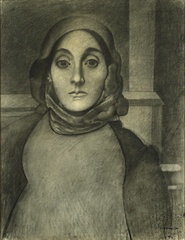
from Art Institute of Chicago collection
Ararat was filmed in Toronto and the Drumheller area of Alberta, with some footage of old churches, church art, and Mount Ararat from Turkey. The leading actors, Egoyan’s wife Arsinee Khanjian and Charles Aznavour, are Armenian. Lovely opera singer, Canadian-Armenian Isabel Bayrakdarian sang some of the hauntingly beautiful background music.
There is so much more, so if you haven’t seen it yet, I recommend it highly, especially on DVD, as it’s great in providing a lot of background to the film.
November 30, 2004 in Films, History 10 Comments »
© Marja-Leena Rathje 2004-2024